The Intel 6th Gen Skylake Review: Core i7-6700K and i5-6600K Tested
by Ian Cutress on August 5, 2015 8:00 AM ESTGenerational Tests on the i7-6700K: Legacy, Office and Web Benchmarks
Moving on to the generational tests, and similar to our last Broadwell review I want to dedicate a few pages to specifically looking at how stock speed processors perform as Intel has released each generation. For this each CPU is left at stock, DRAM set to DDR3-1600 (or DDR4-2133 for Skylake in DDR4 mode) and we run the full line of CPU tests at our disposal.
Legacy
Some users will notice that in our benchmark database Bench, we keep data on the CPUs we’ve tested back over a decade and the benchmarks we were running back then. For a few of these benchmarks, such as Cinebench R10, we do actually run these on the new CPUs as well, although for the sake of brevity and relevance we tend not to put this data in the review. Well here are a few of those numbers too.

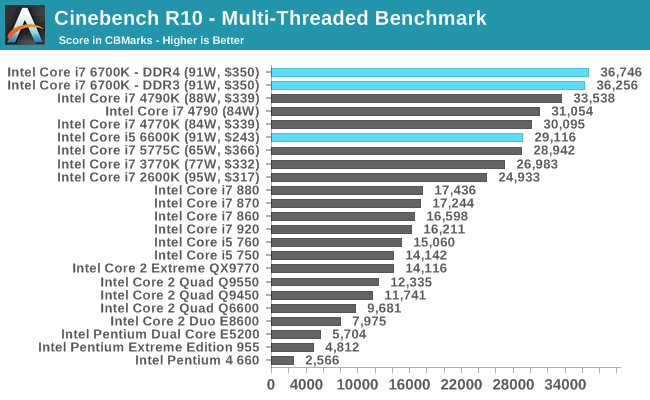


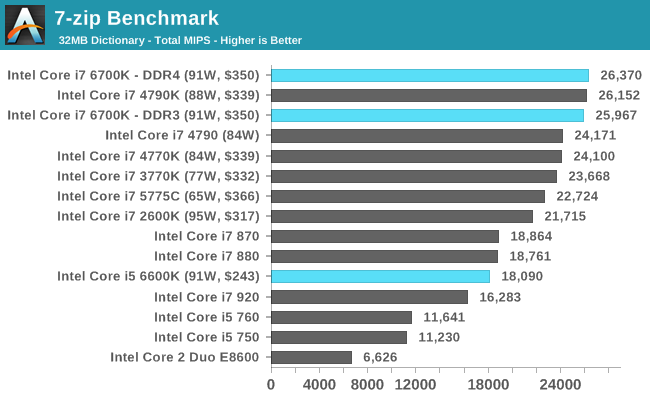
Even with the older tests that might not include any new instruction sets, the Skylake CPUs sit on top of the stack.
Office Performance
The dynamics of CPU Turbo modes, both Intel and AMD, can cause concern during environments with a variable threaded workload. There is also an added issue of the motherboard remaining consistent, depending on how the motherboard manufacturer wants to add in their own boosting technologies over the ones that Intel would prefer they used. In order to remain consistent, we implement an OS-level unique high performance mode on all the CPUs we test which should override any motherboard manufacturer performance mode.
Dolphin Benchmark: link
Many emulators are often bound by single thread CPU performance, and general reports tended to suggest that Haswell provided a significant boost to emulator performance. This benchmark runs a Wii program that raytraces a complex 3D scene inside the Dolphin Wii emulator. Performance on this benchmark is a good proxy of the speed of Dolphin CPU emulation, which is an intensive single core task using most aspects of a CPU. Results are given in minutes, where the Wii itself scores 17.53 minutes.
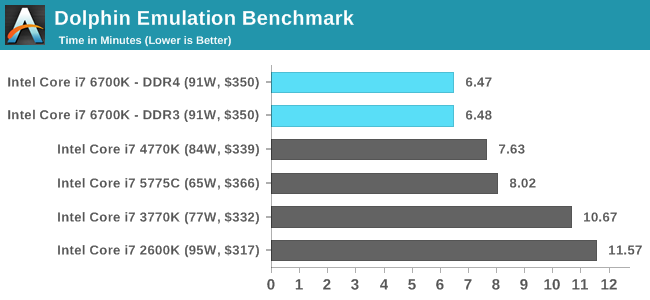
WinRAR 5.0.1: link
Our WinRAR test from 2013 is updated to the latest version of WinRAR at the start of 2014. We compress a set of 2867 files across 320 folders totalling 1.52 GB in size – 95% of these files are small typical website files, and the rest (90% of the size) are small 30 second 720p videos.

3D Particle Movement
3DPM is a self-penned benchmark, taking basic 3D movement algorithms used in Brownian Motion simulations and testing them for speed. High floating point performance, MHz and IPC wins in the single thread version, whereas the multithread version has to handle the threads and loves more cores.
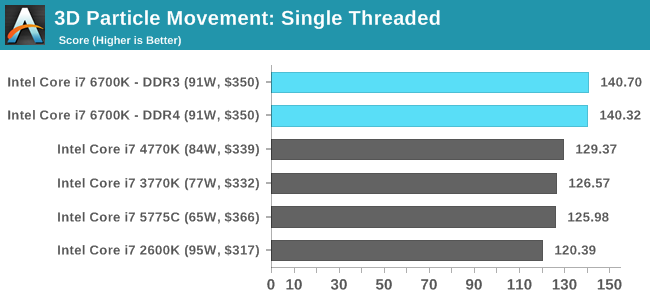
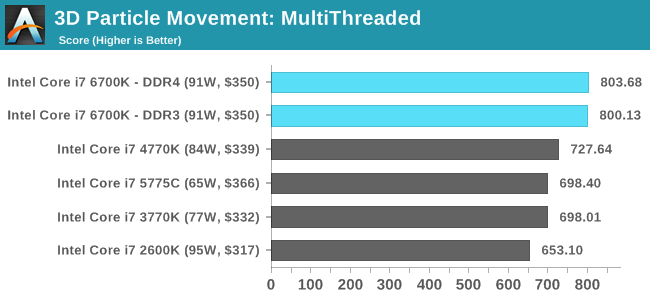
FastStone Image Viewer 4.9
FastStone is the program I use to perform quick or bulk actions on images, such as resizing, adjusting for color and cropping. In our test we take a series of 170 images in various sizes and formats and convert them all into 640x480 .gif files, maintaining the aspect ratio. FastStone does not use multithreading for this test, and results are given in seconds.
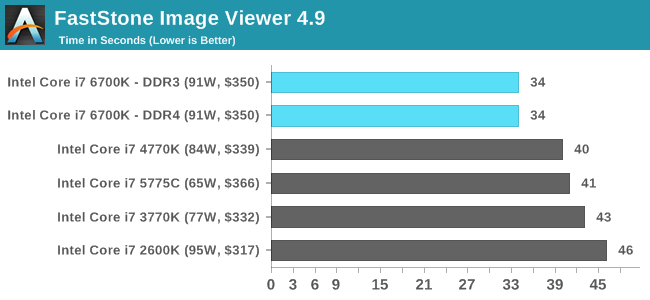
Web Benchmarks
On the lower end processors, general usability is a big factor of experience, especially as we move into the HTML5 era of web browsing. For our web benchmarks, we take four well known tests with Chrome 35 as a consistent browser.
Sunspider 1.0.2
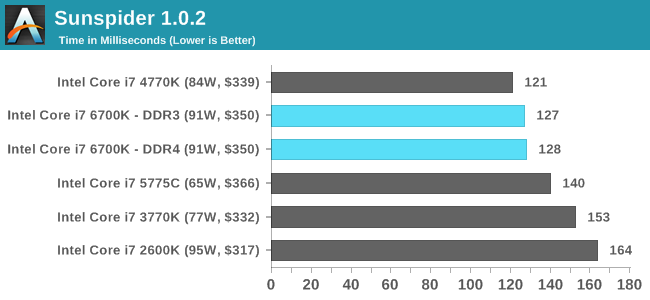
Mozilla Kraken 1.1
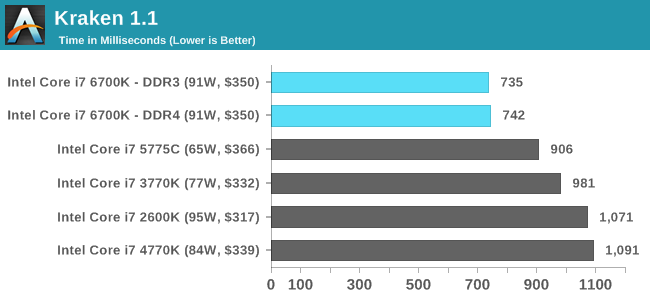
WebXPRT
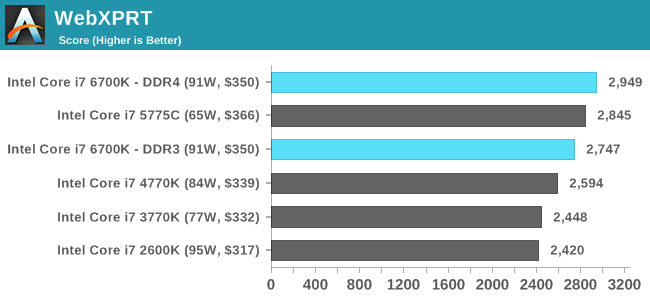
Google Octane v2
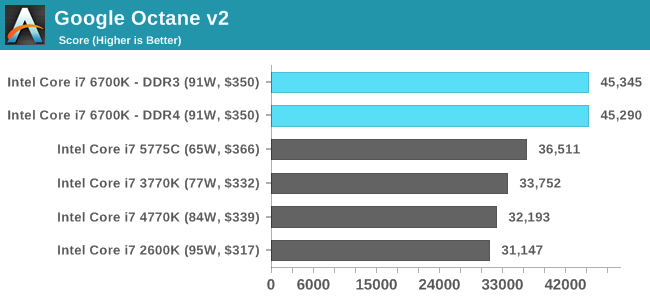










477 Comments
View All Comments
asmian - Sunday, August 9, 2015 - link
>Somehow I doubt it...Sorry, no edit - I meant of course the reverse, that 2 extra cores is DEFINITELY better than marginal extra IPC at a slightly higher overclock, despite the slightly higher TDP. Quad-core Skylake at this price AND requiring DDR4 makes Haswell-E look very good indeed.
Ethos Evoss - Sunday, August 9, 2015 - link
Why they STILL calling it i7 an i5 i3 ... they supposed to change it this time differently ..like i4 i6 i8 ?? or rather without that apples ''i'' ?
orion23 - Sunday, August 9, 2015 - link
Yay for my 2600K @ 4.8ghz from day 1Never had as much fun overclocking and building system
By now, I've changed cases (3x) and PSU's (2X), VGA's (2X). But not my loyal 2600K :)
What a workhorse it is
Kutark - Sunday, August 9, 2015 - link
I think a lot of people in the comments aren't really understanding the article. They state that the best reason to upgrade isn't really the processor speed, its all the other things the new platform affords you.In particular im very happy that i will FINALLY be able to get an SSD with speeds faster than what SATA3 allows as many of the motherboard for the z170 have m.2 thats not running on sata but on PCIE channels. It also allows for some real bandwidth in SLI situations. I have a single 980ti, and this platform would allow me to SLI another down the road and not impede things.
Granted, its not a good value proposition when you look at the end result, but its a very nice future proofing platform in my opinion.
Its kind of like saying if you have a modded older mustang thats as quick as a new mustang that you shouldn't upgrade because its just as or maybe slightly faster. There are more factors to the equation. Things that add to the quality of life, etc.
In skylake's its mostly stuff related to the chipset. IMO thas fine by me.
sonny73n - Wednesday, August 12, 2015 - link
I think you're an idiot. Understanding the article is one thing, realizing how close it is to the truth is another. Sure it's a nice upgrade for anything prior to Sandy Bridge but the author has summed up this article with a bold statement "Sandy Bridge, Your Time Is Up" which I believe - a false statement. Should I have a 5th grader break down the calculation of upgrade options so you can understand? First, note to mind that there's no such thing as future proofing in PC hardwares like you said and K series are made for overclocking.Let break down the upgrade options for my rig - Z68 MB $190, 2500K $230, HSF $60, 8GB RAM $60, PSU $180, GTX 780 $480, SSD $180, Case $80. Total $1460.
Option 1: Upgrade MB, CPU, HSF and RAM. Old components ($540 new) can eBay for ~$200. New components $560 - $200 = $360 (out of pocket). Performance gain: System Overall 30%, Gaming 3 to 5%.
Option 2: Upgrade the whole system. Total $1480. Performance gain same as option 1. Now having 2 systems (wonder what I'm gonna do with both).
Option 3: Upgrade for gaming. Another GTX 780. Performance gain: BF3 1920x1200 4xAA about 95%. Total $480.
Sure Skylake has some new features. Do I need them? NO. Do my SSD saturate SATA3 bus (throughput around 550MB/s)? NO. Is there any program (beside Handbrake which I use rarely) that can utilize the full power of my 2500K OCed mildly at 4.2GHz? NO. Can 980ti SLI saturate PCI-e2.0? NO. Am I such an idiot that I have a good running Mustang but I still like to buy another just because it's a bit better? NO. Is being financially irresponsible add to the quality of life? NO.
Anyone with a brain that has a SB system or newer would never pick the first 2 options.
mapesdhs - Wednesday, August 12, 2015 - link
If there was a thumbs-up button for your post, I'd be clicking it. :Dsonny73n - Thursday, August 13, 2015 - link
Thanks :-) I wish I could explain it better. He's probably wondering why there's a $20 different lol. Hint CPUKutark - Thursday, August 20, 2015 - link
This is pretty hilarious and just further proves my point. You had a fundamental misunderstanding of what the article is stating. You also have a fundamental understanding of the concept of an opinion. This article is not a encyclopedia brittanica article trying to create statements of fact. It is the OPINION of this website that sandy bridge's time is up. I tend to agree with them. And i'm on sandy bridge.Like most internet heroes, you're focusing on one aspect, price/performance. People buy products for a multitude of other reasons. Just simply getting a pure speed upgrade isn't always the primary factor behind the decision.
For example, i bought a VW GTI a few years back instead of a Mazdaspeed 3, even though the mazdaspeed 3 was a better performing car, and was cheaper. I bought the VW because of the intangibles. I liked the way it drove, i liked the interior design better, the exterior design better, etc etc etc.
I will be buying a skylake platform because i like the options the chipset affords me moving forward, in particular the increased number of PCI express lanes which will come in useful when m.2 pcie SSD's come down in price.
And please don't talk to me about financial responsibility. We're not talking about buying a $500k house when you can really only afford a $300k house. Most of us make enough money that while $1k isn't insignificant, it's not going to break the bank either. Get your head out of your ass.
But, please, continue on making an ass of yourself, if nothing it is entertaining...
FullCircle - Monday, August 10, 2015 - link
I'm still happy with my SandyBridge i7-2600k.I see no reason to upgrade for 25% performance boost...
I just upgraded my graphics card from GTX 580 to GTX 970, giving me a performance boost of 250%... now that's a worthwhile upgrade...
25% on the other hand? That's not worth it. CPU advancement has slowed so much there's not much reason to upgrade at the moment unless you have an incredibly old processor. Even the Core i7 processor I have in my old PC is still pretty good.
mapesdhs - Wednesday, August 12, 2015 - link
I upgraded from 3GB 580 SLI to one 980 and even that was a good speed increase. Rocking along with a 5GHz 2700K. For a 2nd system to drive a 48" TV, I considered HW, but in the end for the games I'll be playing (which can use more than 4 cores) a used SB-E build made a lot more sense. ASUS R4E only 113 UKP, 3930K only 185 UKP, etc. Only key item I bought new was another 980.It's pretty obvious with hindsight that Intel jumped ahead much more than they needed to with SB/SB-E, so we won't see another leap of that kind again unless AMD or some other corp can seriously compete once more, just as AMD managed to do with Athlon64 back in the day. All this stuff about bad paste under the heat spreaders of IB, HW and still with SL proves Intel is dragging its feet, ditto how lame the 5960X compares to XEONs wrt its low clock, TDP, etc. They could make better, but they don't need to. Likewise the meddling with the PCIe lanes for HW-E; it's crazy that a 4820K could actually be better than a 5820K in some cases. Should have been the other way round: 5820K should have been the 6-core low end with 40 lanes, next chip up at current 5930K pricing should have been an 8-core with 40 lanes, 5960X should have been an 8 or 10 core with 64 or 80 lanes (whatever), with a good 3.5 base clock, priced *above* the current 5960X a tad - that would have been a chip the real enthusiasts with money to burn would have bought, not the clock-crippled 5960X we have atm.